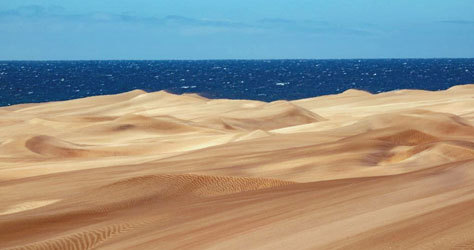- Quarantine Goats, peacocks, wolves and all kinds of wildlife take to the streets
- Malaga.The Caminito del Rey, the most dangerous trail in the world, on a 360 degree tour
The image of a handful of people jumping through the air or making the croquette over the dunes of Maspalomas, one of the main attractions of Gran Canaria, is one of the most persecuted on Instagram. But you can have your days numbered. The absence of locals and tourists has restored its former splendor to one of the most impressive landscapes on the island, classified as a special nature reserve and in a worrying state of deterioration in recent times due to the incessant human presence.
Environmental experts at the Cabildo say this open-air monument sports the original look it looked more than 50 years ago after two months of confinement. Without thousands of daily footsteps and daily jumps, the reserve is more virgin than ever , without footprints of any kind and with the undulations that go to the Atlantic Sea much more marked.
In order for this unusual image to continue, the Cabildo has promised to intensify surveillance after the pandemic to reduce its number of visitors and that no images like this will be produced on Instagram before the decree of the state of alarm.
See this post on Instagram
The state of alarm caused by the Covid-19 crisis has led to the recovery of ecological processes in the area, highlights Miguel Ángel Peña, technical director of the Masdunas project, dependent on the Cabildo. Its objective is formulas to stop the process of environmental degradation that has been taking place during the last five decades in the place due to excessive wear.
Disappearance of the dunes
To the point that, if this continues, it could cause the disappearance of this field of mobile dunes in the coming years. Still, experts are hopeful about nature's ability to regenerate if given respite, as has been the case. It is a way of maintaining the environmental value of the reserve and its relevance as a tourist attraction.
Not surprisingly, the reserve is located in San Bartolomé de Tirajana, the southern municipality of Gran Canaria that led the number of tourist overnight stays in our country in 2019 behind only Madrid and Barcelona. And the dunes of Maspalomas are very much to blame for this influx of travelers, eager to see a prodigy of nature like this in the first person.
Repopulation of the area
The Masdunas project also includes the repopulation of the area with the plants called balancones , which manage to trap the sand to form new dunes that are incorporated into the ecosystem. The Charca de Maspalomas, in addition, has managed to attract the migration of countless birds to the area due to the tranquility that the place now breathes.
The return to the original state of the Maspalomas dunes is not the only case of how the wild nature has taken over the cities and towns of half the world due to the absence of people on the streets during confinement. And especially quarantines. There are many more. Peacocks strolling as if such a thing through the streets of Madrid. Wild boars on the Diagonal in Barcelona. A cougar through the center of Santiago de Chile. Goats crossing a zebra crossing in a locality in Wales. Foxes alternating between the San Francisco streetcars .
Also pollution has been reduced dramatically across the globe and we have even seen cities like Venice return to the blue color of its waters between channels.
In accordance with the criteria of The Trust Project
Know more- Stay at home
- Spain
- Canary Islands
- tourism
Summer Holidays in town, beaches without foreigners and more sustainable trips, this will be Spanish tourism in the coming months
# ViajaMañana Guided tours of Spain: a luxury plan at bargain prices
Islands La Graciosa and the Chinijas archipelago, survivors of the Spanish coast

